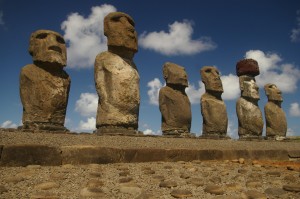WalkwithGod.com » Blog, Inspirational » Lessons from Easter Island: Why Wise Parents Rock
Lessons from Easter Island: Why Wise Parents Rock
 Easter Island is a remote island in the Pacific. Located almost 2200 miles to the west of Chile, it is one of the most isolated islands which is inhabited. Inhabited by very few peopled, nonetheless the island is famous worldwide for its huge-headed statues which line the coast.
Easter Island is a remote island in the Pacific. Located almost 2200 miles to the west of Chile, it is one of the most isolated islands which is inhabited. Inhabited by very few peopled, nonetheless the island is famous worldwide for its huge-headed statues which line the coast.As a child I read about Easter Island, saw pictures of the statues and used to wonder who made them. Why were they on the coast? What did they represent? How did their builders manage to move such large carvings without heavy equipment?
Children have that natural curiosity. It seems that one of the first games that children know without the benefit of being taught is the game of twenty questions — or forty. “Why is the sky blue?” “How far is K-mart?” “Why does the sun come up in the East?” “Why does the preacher shake his head back and forth when he preaches?” “Why is that man running down the road without a shirt on?” You know the drill. Question after question after question.
Truthfully, it’s easy to run out of patience before we actually run out of answers. Rather than continuing to answer questions, we flash an exasperated look and say, “Stop asking so many questions!” This usually is good for about a ten minute reprieve.
But Easter Island is one of those places that just naturally evokes a bit of wonder and questions — even from adults. Sometime in the distant past, groups of laborers each worked for about a year to carve one of those statues (there are over 800 of them). Then they carted them on sleds or some other clever device all the way from the quarries to the coast. Finally, they had to erect the statues in the proper place. Why? Who would do this? What is the purpose? Don’t you wish you had a chance to sit and listen to some of the stories that surround these monoliths?
Rocks and stones. Men especially seem to have a fascination with rocks. What boy hasn’t left his Mom a present of a pocketful of rocks to fish out before she does laundry? In Bible times, Joshua seized this natural inclination and used it to drive home some very important points. Several times in the book of Joshua beginning with the entry into the land of Canaan and during the conquest of the territory, we read of Joshua either setting up piles of stones or writing things on stones. After God parted the waters of the Jordan River and Israel crossed on dry ground, Joshua commanded the hand-picked men of the twelve tribes to each carry a stone out of the midst of the Jordan while they were passing through the riverbed. When they reached the other side, Joshua built a pillar of the twelve stones as a memorial to the miracle God had worked in their behalf.
Why did he do this? Was it for the benefit of the people who had walked through the Jordan? No. They didn’t need a photograph or a video of something they had personally experienced. Listen to what Joshua said: “In the future, when your children ask you, ‘What do these stones mean?’ tell them that Israel crossed over on dry ground… God did this so that all the Earth would know that He is powerful and that we might fear Him always.”
Hmm. An inexplicable pile of rocks. Questions from the mouth of a child. A good story to listen to. It sounds like the recipe for something memorable.
What about you? What is your Easter Island statue? Your pile of twelve stones? Your large boulder under a tree (Joshua 24:26-27)?
A wise parent knows that children WILL ask questions. A wise parent will erect some monuments, some memorials, some visible memories of the work of God in order to provide a focal point for his child’s natural curiosity. And a wise parent will make time to say, “I’m glad you asked me that. Let me tell you a story…”
In telling the stories of the time God provided money to pay the bills, the time God saved us from certain harm or death, the time that God spoke a clear word to give guidance when all of life was confusion, the time that God set us free from a life-controlling sin, the time that God took away a load of guilt and shame and replaced it with freedom, purpose and love — in telling THOSE stories, we are letting our children know that God is not some fairy tale like Santa Claus or the Easter Bunny. He is real. He is powerful. He still heals people from deadly sickness. He still sets the addict free. He still provides food and shelter. And He is intimately involved in the lives of His children. In telling THOSE stories, we introduce the living God to our children, and we ourselves are reminded of just some of the reasons that we both fear and love Him, why He deserves our best, our fullest, our very lives.
Maybe it’s a photograph you need to pull out and hang on your wall. Maybe it’s a significant date you need to print in nice script and place on a mirror. Maybe it’s a series of colors to describe a simple progression of events which led you from darkness to light. Put them in front of your children. Wait for the questions. Tell the stories.
Filed under: Blog, Inspirational











